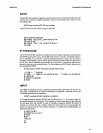
Commands and Statements
6-10
KILL
The KILL command deletes files from disk storage,
and
removes all references to
the deleted file from the directory.
Once a file has been killed, it cannot be reopened.
KILL filename
LET
The LET statement
is
used to give a value to a variable.
If
a variable appears to the
left
of
an
equal sign not preceded by the word LET,
BASIC-SO
assumes that a LET
statement
is
implied. When assigning a literal value to a string variable, the value
must be enclosed in quotation marks.
[LET] variable = expression
10
LET
A=5
20
PRINT A
RUN
5
Ok
LINE INPUT
The LINE INPUT statement reads
an
entire line
of
data and assigns it as the value
of
the specified string variable. LINE INPUT does this in two ways: first, data may be
read from the terminal and assigned; second, data may be read from a disk file and
assigned.
When entering data from a terminal, the syntactic format is:
LINE
INPUT
[string expression;] string variable
This statement
will
print the string expression as a prompt and will haIt until the
string
is
entered and a carriage return has been entered. Entering a Control-C
will
abort LINE INPUT and return
BASIC-SO
to the Command Mode. A CONT com-
mand may then be used to re-enter the LINE
INPUT statement.
When entering data from a disk file, the syntactic format used
is:
LINE
INPUT
.file
number,string variable
This statement reads data from the specified disk file until a carriage return
is
en-
countered. The data
is
assigned as a value for the specified string variable, and LINE
INPUT skips over the encountered carriage return-line feed to point to the begin-
ning
of
the next string.
If
no carriage return
is
encountered, the statement returns
the next
255
characters
of
data.
See
Chapter 5 for further information about disk
file
I10~
LIST
The LIST command prints the current program's text
to
the console. Instruction
lines are listed in sequential order. As shown below, the
LIST command may be used
to display the entire program, all instruction lines up to or after a given line, or a
block
of
instruction lines within the program. The period may be used as
an
abbreviation for the last line which was changed, contained an error, or was listed.
LIST [line numberl-line numbeq line number-I line number-line number}
BASIC-SO


















